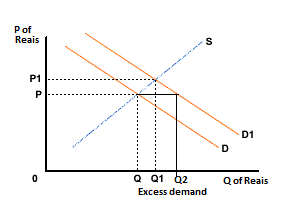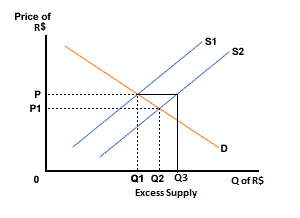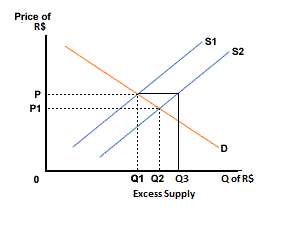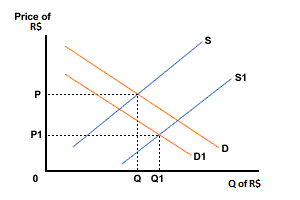Causes of changes in exchange rate
Syllabus: Explain the factors that lead to changes in currency demand and supply, including
- foreign demand for a country’s exports, (PoPzTEP foreign)
- domestic demand for imports, (PoPzYTEP domestic)
- relative interest rates, (investment and savings)
- relative inflation rates, (Po)
- investment from overseas in a country’s firms (foreign direct investment and portfolio investment) and
- speculation. (Hot money)
As already shown, the exchange rate is affected by the state of the economy indicated by inflation, interest rates and balance on trade. We now consider these influences using the example of the Brazilian economy.
Balance of trade
For each example try to reason through what the outcome will be, using a diagramA surplus in the balance of trade (X>M) means that DR$ > SR$ , i.e. there is net increase in DR$ . This causes upward pressure on the exchange rate because of the excess demand. The exchange rate will appreciate from P to P1 - Just think ESEPME. This is illustrated in Figure 1 below (but I cannot find dotted lines in paint for the excess):

Figure 1 Brazilian trade surplus - impact on exchange rate
Alternatively, a deficit in balance of trade will result in net increase in SR$ and result in downward pressure on the exchange rate as shown in Figure 2 below. The exchange rate will depreciate from P to P1.

Figure 2 Brazilian trade deficit - impact on exchange rate
Interest rates
Differences in interest rates between different countries affect the
investment flows (capital flows) between these countries and will, in
return, affect the exchange rate. Simply put if interest rates
Capital flows exert a greater influence on exchange rates than trade flows in developed countries. This is because the fund managers of international financial organisations and multinational corporations, and rich individuals, move more money around the globe on a daily basis than is accounted for by trade flows. They do this to take advantage of differences in relative interest rates and changes in exchange rates, or they may be speculating on future movements in such variables.
If interest rates were to fall (in Brazil) below those in other major economies, or international speculators were pessimistic about the future of the Brazilian economy, or predict a large depreciation in the Real, they might decide to sell their holdings of R$ and convert them into dollars. This would increase the demand for US$, while increasing the supply of R$'s, which causes a depreciation of the currency. This can be seen in Figure 3 below:

Figure 3 Brazilian capital outflows - impact on exchange rate
An increase in Brazilian interest rates relative to others, or greater optimism about the future of the Brazilian economy will enable investors to earn higher returns. Consequently, speculators / fund managers might decide to move funds currently being held in US$ into R$. This will have the reverse effect - the R$ will appreciate as the demand for it increases (indicated by a rightward shift of the demand curve for R$ - see figure 1).
Inflation
A higher rate of inflation in Brazil, than in other countries, will make Brazilian exports less competitive (more expensive) and may lead to less exports being sold, depending on the price elasticity of demand for exports. If this causes a worsening of the current account (X-M), the exchange rate will depreciate. With less demand for exports (more expensive) and imports becoming relatively cheaper, the demand for R$ will fall, while the supply will increase. This is shown in Figure 4 below:
 NB
having a diagram with 2 curves shifting at the same time leads to an
indeterminant outcome as it depends then on relative PED to PES. For
example - where is the excess on this diagram? Personally I would use
two diagrams unless you are really confident on outcomes.
NB
having a diagram with 2 curves shifting at the same time leads to an
indeterminant outcome as it depends then on relative PED to PES. For
example - where is the excess on this diagram? Personally I would use
two diagrams unless you are really confident on outcomes.
Figure 4 Impact of higher inflation on the exchange rate
The opposite might be the case, i.e. an appreciation of the R$, if the rate of inflation in Brazil fell below that in other countries.
Inflation may also be a factor which currency speculators take into account when making decisions about buying/selling currencies. If a very high, uncontrollable rate of inflation was expected (hyper-inflation), speculators may lose confidence in the currency and sell, causing it to depreciate in value.
